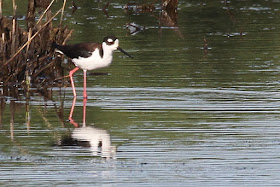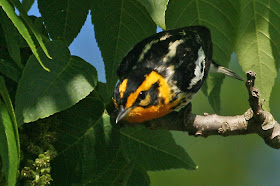The dates for our annual Cape Maygration spring weekend event obviously have to be planned well in advance, so that venues can be booked, diary dates can be set and everything can be put in place to ensure that our eager visitors are all assured of a good time. But the weather? And the birds? Well, that's out of our hands and, believe me, this year was somewhat fraught to say the least! Weather trends this spring have not been bringing high numbers of migrants to anywhere on the east coast and we've seen 35-40 degree swings in temperatures in 24 hour periods on a regular basis. In the event, things worked out pretty well. Though we had some soggy spells at times (thankfully nothing like the downpours we had on World Series this year!) we mostly enjoyed pretty good weather. But what of the birds? Blocking wet weather systems continued to track east across the Mid Atlantic states to the south of us, pretty much cutting off any chance of a big fall out, but birds did get through and I know for sure that there was a whole bunch of smiling faces heading out of Cape May after the weekend - actually, many of those same faces are still here and still enjoying the magic of May in Cape May (did they really name the month after the place?!!).
From warblers at Higbee Beach and The Beanery to outstanding shorebird gatherings at Heislerville and Brigantine, via horseshoecrabs, backbay boat trips and breeding birds at Belleplain, here's some of what people came, saw and enjoyed...
The weather may have been moody at times, but dull, damp spells bring the insects down lower and with them come the birds that feed on them. It's a great birding day when you see Chimney Swifts so close that you can count the spines on the tail feathers! [photo by Mike Crewe]
Winds that were unfavorable for northbound songbird migrants brought us some pleasant surprises, including some days when raptor movements on NW winds made us wonder whether we had skipped summer and gone straight into fall! As well as a sprinkling of Broad-winged, Red-shouldered and young Red-tailed Hawks, at least three Swallow-tailed Kites have passed this way of late, including this one, circling high with Turkey Vultures over The Beanery [photo by Mike Crewe].
Walks at The Meadows and the state park were frequently brightened by passing parties of Brown Pelicans - such as this group that circled over the beach ahead of us on Saturday afternoon [photo by Mike Crewe]
As well as migrants, breeding birds were here to be enjoyed and many of them performed perfectly for us. At Jake's Landing, Marsh Wrens were determined not to be ignored...
...this Wood Thrush gathered up spent oak catkins for nest material on the side of the road in Belleplain State Forest...
...Least Terns performed death-defying power dives at The Meadows...
...and the poor old Ospreys continued to run the gauntlet of our local Bald Eagles [photos by Mike Crewe].
Other local breeding birds ensured that backbay boat trips were always accompanied by much activity. Eastern Willets are very much the sight and sound of Cape May saltmarshes throughout the summer...
...Ospreys work diligently to ensure that not a single available nest space is left unoccupied...
...and Clapper Rails - with a little patience - do eventually come out for a wash and preen after caking themselves in black mud while pursuing fiddler crabs [photos by Mike Crewe].
Just up the road at Heislerville, our walks provided excellent opportunities to savor the hustle and bustle of a breeding colony of herons, egrets and cormorants...
...with much activity from Black-crowned Night Herons as they collected twigs for their nests.
And of course Heislerville has built up a great reputation for attracting masses of shorebirds in spring, giving plenty of opportunity to scan through for itinerant phalaropes, Black-necked Stilts, Curlew Sandpipers and other goodies.
But it is as a resting location for thousands of Semipalmated Sandpipers that Heislerville really excels, and allows researchers from NJ Audubon and other organizations to study the worrying downward population trend of this species [photos by Mike Crewe].
While we won't have this year's data for a while yet, early signs of horseshoecrab activity instill mixed feelings. Numbers are still a lot lower than they should be to ensure a healthy population but, on the other hand, they seem to have taken readily to beaches that were artificially replenished after Hurricane Sandy stripped all the sand away last year...
...and for birdwatchers, this has meant plenty of great viewing opportunities as Red Knot, Ruddy Turnstones and Semipalmated Sandpipers take on vital fuel to get them to their breeding grounds. [Photos by Mike Crewe]
And as if all that was not enough - the warblers came, right on time! Numbers may well have been lower than we would have liked, but a great mix of species was here to be enjoyed, and fewer birds meant more time to relax and enjoy those that were here! Walks at Cape May Point, The Beanery and Higbee Beach gave us nice encounters with Black-throated Green Warbler...
...Magnolia Warbler...
...the flame-throated Blackburnian Warbler...
...breeding-plumaged Blackpoll Warblers...
...and - one of my favorites as it is scarce down here in spring - Bay-breasted Warbler (a little grainy here as it lurked in deep shadow in The Beanery's wet woods) [photos by Mike Crewe]
Well, if that lot doesn't get you fired up to come down to Cape May right now, I don't know what will - perhaps if I tell you that a flock (yes a flock!) of seven Mississippi Kites is lurking right outside the observatory window right now...
See you in the field!!!

























































